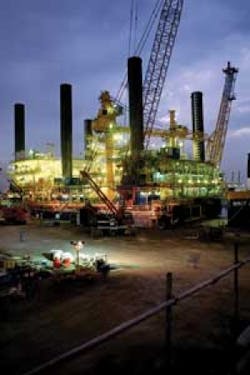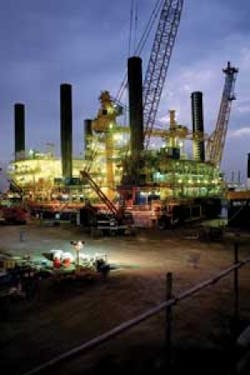Gene Kliewer,Technology Editor, Subsea & Seismic
The latest plans for the $3.1-billion Phase I of Jubilee offshore Ghana call for first oil before the year is out. According to operator Tullow Oil, this first phase has nine production wells reaching 120,000 b/d of oil with six water injection and two gas injection wells maintaining the drive.
With all the Phase I drilling complete at Jubilee, the downhole equipment for production and water/gas injection are being installed by theEirik Raude, and an FPSO for the field is in construction at Singapore. Earlier this year work on installation of the process modules, external turret, and commissioning were proceeding on schedule. The subsea equipment is ready for installation, says Tullow, and work on installation of flowlines, seabed piles, manifolds, and control umbilicals is in progress.
Tullow has ordered 19 subsea trees from FMC for Phase I, and FMC also supplies the manifolds.
Tullow says the Jubilee Unit Area has a gross resource base of 500 MMbbl of oil (P90) through a most likely 700 MMbbl (P50) to an upside of 1,000 MMbbl (P10).
Angola’s Upcoming Oil Projects | ||||
Project | Location | Operator | Peak Production (total liquids) | Expected Start-up | Peak |
Negage | Block 14 | Chevron | 75,000 b/d | 2010+ |
Pazflor | Block 17 | Total | 200,000 b/d | 2011 |
PSVM (a) | Block 31 NE | BP | 150,000 b/d | 2011 |
Kizomba D | Block 15 | ExxonMobil | 120,000 b/d | 2011+ |
CLOV | Block 17 | Total | 150,000 b/d | 2011+ |
Other block 31 | Block 31 | BP | 300,000 b/d | 2012+ |
PCC (b) | Block 18 | BP | 100,000 b/d | 2012+ |
Other Block 32 | Block 32 | Total | 120,000 b/d | 2012+ |
a) Plutão, Saturno, Vênus, and Marte b) Platino, Chumbo, Cesio | ||||
While Total is looking at similar technological schemes to those it has used already off Angola, the FPSO might have a twist. According to Total, the processing and storage system will be designed to handle two types of oil. The Cravo-Lirio Oligocene production is 32-35º API crude and the Violeta-Orquidea production is 20-30º API. Thirty-four subsea wells will tieback to the CLOV FPSO, which will have an oil processing capacity of 160,000 b/d and storage capacity of around 1.8 MMbbl.
Cabinda Gulf Oil Co. (CABGOC) has contracted Amec to perform front-end engineering design (FEED) for its Mafumeira Sul project, offshore Cabinda Province, Angola.
Mafumeira Sul will feature a central production complex comprising three platforms, linked by two bridges, and a flare tower. Oil and liquefied petroleum gas will be exported to the Malongo Oil Terminal and theSanhaFPSO, respectively.
The Mafumeira field is in block 0, in water depths ranging from 150-160 ft (45.7-48.7 m). The new infrastructure will provide for future development of additional fields in the southern Malongo area.
Off Gabon, Canadian Natural Resources is drilling from its second platform in the Olowi field. The company says it plans to drill a total of six wells from Platform B and then go to Platform A for additional drilling.
Front-end engineering design work indicates probable areas of future production, so Equatorial Guinea may join the production rush. Noble Energy has contracted Mustang to perform FEED work for the Belinda project in block O offshore Equatorial Guinea.
The scope includes the design of the jacket and topsides to process gas condensate for the offshore facility in 243 ft (74 m) of water. Belinda is being designed as a gas cycling project to extract condensate and re-inject the gas.
The semisubmersibleEirik Raude is drilling the phase 1 wells for the Jubilee field development. Photo courtesy Tullow Oil




